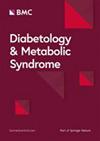Association of triglyceride-glucose index with helicobacter pylori infection and mortality among the US population
IF 3.4
3区 医学
Q2 ENDOCRINOLOGY & METABOLISM
引用次数: 0
Abstract
Limited research has explored the potential association between the Triglyceride-Glucose (TyG) and mortality, especially in individuals with Helicobacter pylori (H. pylori) infection. This study seeks to investigate the correlation between the TyG index and H. pylori infection and investigate whether the associations between the TyG index exposure and all-cause mortality are mediated by H. pylori infection. The study utilized data from the National Health and Nutrition Examination Survey (NHANES) 1999–2018, incorporating a final sample size of 2,187 participants. Both univariable and multivariable-adjusted logistic regression analyses were employed to examine the relationship between H. pylori infection and relevant covariates. To assess the association between TyG index, and all-cause mortality in individuals with or without H. pylori infection, Cox regression analysis, and restricted regression cubic spline analysis were implemented. A significant positive correlation was observed between the TyG index and an elevated risk of H. pylori infection [OR 1.157, 95% CI (1.383 ~ 1.664)]. This correlation persisted even after adjusting for confounding factors [OR 1.189, 95% CI (1.003, 1.411), P < 0.05]. Furthermore, in patients with positive H. pylori infection, a noteworthy nonlinear correlation between the TyG index and all-cause mortality was identified (P = 0.0361). With an increase in the TyG index, all-cause mortality exhibited a corresponding rise, particularly following adjustment for all potential confounding factors. Conversely, in patients with negative H. pylori infection, no significant association was observed between the TyG index and all-cause mortality after adjusting for potential confounding factors. A higher TyG index was linked to increased H. pylori infection risks. Participants in the higher quantile group of the TyG index are positively associated with higher all-cause mortality compared to the higher quantile group of the TyG index in H. pylori-positive participants instead of H. pylori-negative participants.甘油三酯-葡萄糖指数与幽门螺旋杆菌感染和美国人口死亡率的关系
关于甘油三酯-葡萄糖(TyG)与死亡率之间的潜在联系,尤其是幽门螺旋杆菌(H. pylori)感染者的这种联系,目前的研究还很有限。本研究旨在调查 TyG 指数与幽门螺杆菌感染之间的相关性,并调查 TyG 指数暴露与全因死亡率之间的关联是否由幽门螺杆菌感染介导。该研究利用了美国国家健康与营养调查(NHANES)1999-2018 年的数据,最终样本量为 2,187 人。研究采用单变量和多变量调整逻辑回归分析来检验幽门螺杆菌感染与相关协变量之间的关系。为了评估幽门螺杆菌感染与否与 TyG 指数和全因死亡率之间的关系,研究人员采用了 Cox 回归分析和限制回归立方样条分析。结果发现,TyG指数与幽门螺杆菌感染风险升高之间存在明显的正相关性[OR 1.157,95% CI (1.383 ~ 1.664)]。即使在调整了混杂因素后,这种相关性仍然存在[OR 1.189,95% CI (1.003, 1.411),P < 0.05]。此外,在幽门螺杆菌感染阳性的患者中,TyG指数与全因死亡率之间存在显著的非线性相关性(P = 0.0361)。随着 TyG 指数的升高,全因死亡率也相应升高,尤其是在调整了所有潜在混杂因素后。相反,在幽门螺杆菌阴性感染的患者中,在调整了潜在的混杂因素后,TyG指数与全因死亡率之间没有发现明显的关联。TyG指数越高,幽门螺杆菌感染风险越高。与幽门螺杆菌阳性参与者而非幽门螺杆菌阴性参与者中TyG指数较高的量级组相比,TyG指数较高的量级组参与者与较高的全因死亡率呈正相关。
本文章由计算机程序翻译,如有差异,请以英文原文为准。
求助全文
约1分钟内获得全文
求助全文
来源期刊

Diabetology & Metabolic Syndrome
ENDOCRINOLOGY & METABOLISM-
CiteScore
6.20
自引率
0.00%
发文量
170
审稿时长
7.5 months
期刊介绍:
Diabetology & Metabolic Syndrome publishes articles on all aspects of the pathophysiology of diabetes and metabolic syndrome.
By publishing original material exploring any area of laboratory, animal or clinical research into diabetes and metabolic syndrome, the journal offers a high-visibility forum for new insights and discussions into the issues of importance to the relevant community.
 求助内容:
求助内容: 应助结果提醒方式:
应助结果提醒方式:


